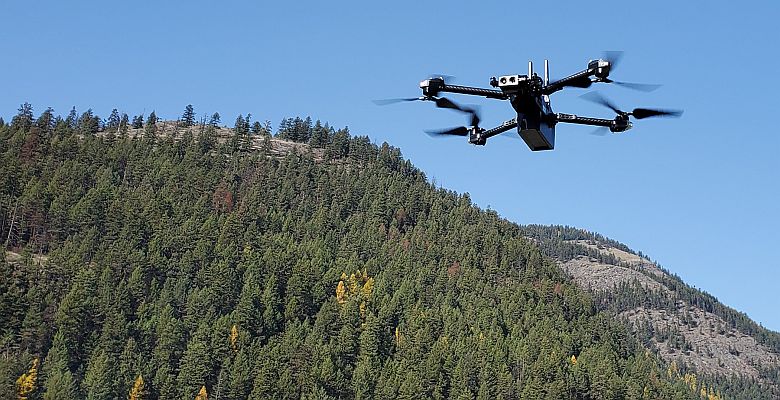Climate change is leading to larger and more frequent forestfires. Drones with sensors can provide faster detection and intervention.
Researchers at Oak Ridge National Laboratory (ORNL) in Oak Ridge, Tennessee, are using sensors, drones and machine learning to both prevent fires and reduce their damage to the power grid. They are refining the technology to remotely detect electrical sparks and faulty equipment, and to determine the direction of spreading fires.
The need is urgent. The largest recorded forest fire years have occurred since 2004, which coincided with many of the hottest years on record. Many forest fires are caused by power lines, while on the other hand forest fires can cause widespread power outages. Electricity companies therefore have a major stake in tackling the crisis.
Drones and sensors
Last fire season, the Department of Energy in Washington (DC) provided funding for a number of wildfire research projects, including at ORNL. The Department chose to accelerate the research because it recognises how critical and dangerous wildfires have become as a result of climate change. Damage from wildfires can cause widespread power outages in several states.
ORNL's work with sensor technology on drones that can go beyond the line of sight is important. This allows authorities to be several steps ahead of problems that could endanger the power grid, making it unreliable and less resilient. Apart from electricity companies, the research is important for fighting wildfires. It also improves fire detection for the US Forest Service, the main agency for fighting forest fires.
Prevention
Sensors placed near high-voltage power lines or in power electronics can detect variations in the power flow that lead to superheated sparks. ORNL researchers are developing an algorithm for quickly recognising and classifying these electrical arcs, which occur when electricity jumps between two conductors.
They are using a library of waveform 'signatures' contributed by utility companies and universities. The signals show spikes in voltage or current caused by anomalies such as arcing. The algorithm detects these anomaly areas. The next steps include training a software programme to recognise similar signatures and determine where arcing occurs. The algorithm, which could be deployed in power electronics, can alert the utility's command centre so that staff can check the location - and whether it is accessible.
Drones
This is where drones come in. Sparks often occur in hard-to-reach rugged areas. Planes and helicopters sometimes cannot get low or close enough to find small arcs. They are also much more expensive to fly and difficult to plan quickly. A promising alternative is the use of drones equipped with sensors that record video. They can detect sound, heat and radio frequency emissions from small arcs. This combined sensory capability can confirm detected problems and overcome interference.
Drones help identify maintenance needs before fires start. ORNL's experience in operating drones beyond the visual line of sight enables inspection of transmission lines over long distances. The Federal Aviation Administration recently granted (unusual) permission to fly drones across the United States, and up to 1500 feet (450 m) with special permission.
Drone-mounted sensors can help find new fires. These are partly caused by embers that can be blown up to a kilometre and a half from the main fire. Only sensors can detect heat under the canopy of trees where no smoke is visible. The drones can also be used to locate hotspots in a burnt area - a task that is now done by hand as firefighters sift through ash.
High altitude
ORNL researchers are also providing sensors for another US Forest Service experiment to detect heat from extreme heights. The sensors can be carried by a balloon or by a solar-powered plane that can stay airborne for a long time. It flies above thunderstorms and checks for fires ignited by lightning strikes. This technology will be tested later this year. This application could reduce the need for guided flights to spot fires, eliminating human risk and using limited resources wisely.
The research team has begun exploring other ways to prevent electrical fires using drone-mounted sensors, such as detecting whether branch lines or transformers are generating excess heat.
Public interest
In California, as in other states in the US, large natural areas go up in flames every year. Also in France, Spain, Portugal, Greece and in the Balkans large wildfires are raging annually. And not to forget Australia.
During a wildfire in the Wears Valley (Tennessee) in 2021, caused by downed power lines, the researchers were given permission from firefighters to use drones. They monitored the temperature in power lines and transformers in the midst of the fire. Even if they survive the fire, transformers can be affected by exposure to temperatures hotter than their operating limits. This monitoring can help determine where equipment needs to be replaced.
The 2018 Camp Fire was the deadliest and most destructive wildfire in California history and the world's most expensive natural disaster that year. The fire caused at least 85 casualties, both firefighters and civilians. It covered an area of 620.5 km2 and destroyed more than 18,800 buildings. The extensive destruction led to the bankruptcy of the utility company.
If research at ORNL can reduce this kind of impact, it will be good for everyone.
Photo: Oak Ridge National Laboratory

